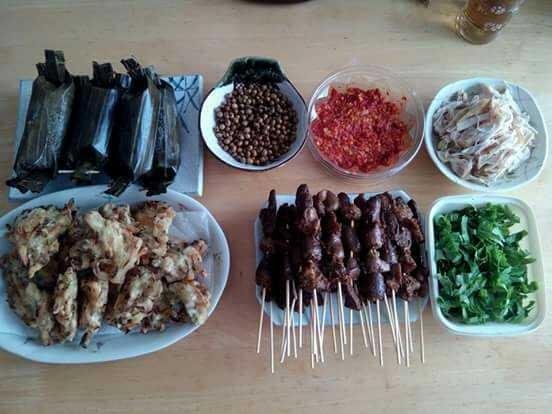Sate

Sate or satai is a food made from small pieces of meat pierced in such a way with a puncture bone of coconut leaves bamboo or bamboo then roasted using charcoal wood coals. Satay is served with a variety of spices that depend on the variation of sate recipe. Meat made satay include chicken, lamb, lamb, beef, pork, rabbit, horse, and others.
Sate is known to originate from Java, Indonesia, and can be found anywhere in Indonesia and has been regarded as one of Indonesia's national cuisine. Sate is also popular in other Southeast Asian countries such as Malaysia, Singapore, Philippines, and Thailand. Sate is also popular in the Netherlands influenced by Indonesian cuisine which used to be its colony.
Sate is a very popular dish in Indonesia; with various tribes and traditions of the art of cooking has produced various types of satay. In Indonesia, sate can be obtained from street vendors, street vendors in street stalls, up to upscale restaurants, and often served in parties and festivities. Recipes and ways of making satay vary depending on the variety and recipe of each region. Almost any kind of meat can be made sate. As the origin country of sate, Indonesia has a variety of rich satay recipes.
Usually sate is given sauce. This sauce can be a spice soy sauce, peanut sauce, or the other, usually accompanied by pickles from sliced red onion, cucumber, and cayenne pepper. Sate eaten with warm rice or, if in some areas served with lontong or ketupat.
Satey international dishes include yakitori from Japan, shish kebabs from Turkey, shashlik from Caucasian, chuanr from China, and sosatie from South Africa. Sate is listed as 14th place in the World's 50 most delicious foods.
Satay has become a popular food widely in different parts of the world, it makes people interested to know the origin of this popular dish:
"Although Thailand and Malaysia consider this dish to be theirs, the real satay ground in Southeast Asia is Java, Indonesia, where sate is developed from the adaptation of Indian kebab brought by Muslim traders to Java and even India can not recognize its origin this dish is Middle Eastern influences. "
The word "satay" or "satai" is supposedly derived from the Tamil language. Suspected sate was created by street food traders in Java around the beginning of the 19th century, based on the fact that satay became popular around the beginning of the 19th century along with the growing number of immigrants from Arab and Muslim immigrants Tamil and Gujarat from India to Indonesia. This is also the reason for the popular use of mutton and sheep as a sate which is preferred by people of Arab descent. In the Indonesian Muslim tradition, the feast of Eid al-Adha or the feast of the sacrifice is a special event. On this feast day the sacrificial meat is abundant and distributed to the poor and the poor. Most celebrate by grilling satay sate goat, lamb, or beef.
Another theory suggests that the origin of the word sate comes from the term Minnan-Tionghoa sa tae tub which means three pieces of meat. However, this theory is doubtful because traditionally sate consists of four pieces of meat, not three. And the number four is considered not a number that brings good luck in Chinese culture. Indonesian Chinese also adopted and developed satay according to their taste, namely pork satay served with pineapple sauce or sweet soy sauce with additional Chinese spices, so the Chinese sate has a taste like a typical Chinese roast beef dish.
From Java, sate spread throughout the archipelago of Nusantara that produces a wide range of varieties of satay. At the end of the 19th century, sate had crossed the strait of Malacca to Malaysia, Singapore, and Thailand, brought by Java and Madurese migrants who started trading sate in the neighboring country. In the 19th century the term satay moved along with the migration of Malay migrants from the Dutch East Indies to South Africa, where the satay was known as sosatie. The Dutch also brought this dish and many other typical Indonesian dishes to the Netherlands, until now the Indonesian cooking art also influences the art of Dutch cooking. Chicken satay or pork satay is one of the side dishes served in Rijsttafel dish in Holland.
Seeing the picture of the satay, makes the stomach growl. it tastes great.